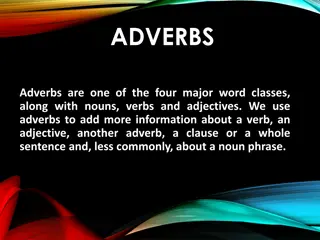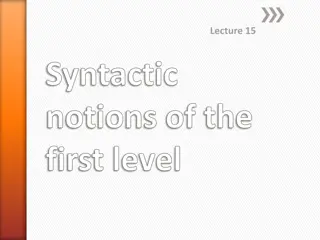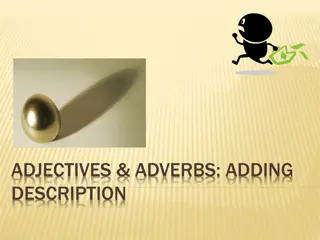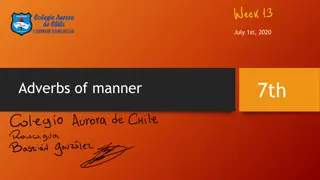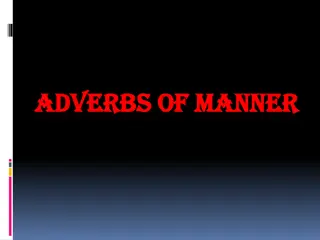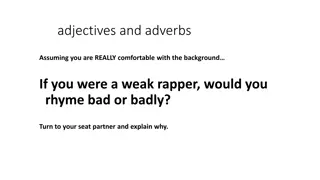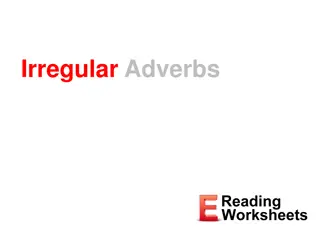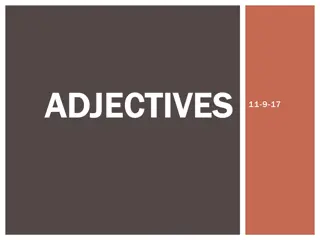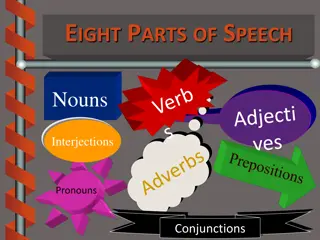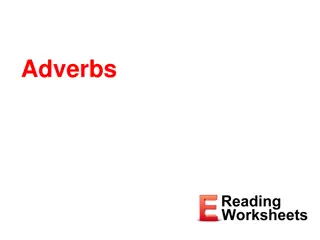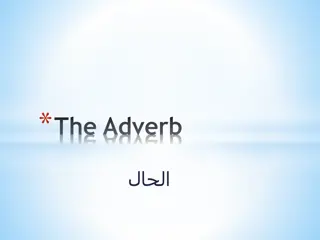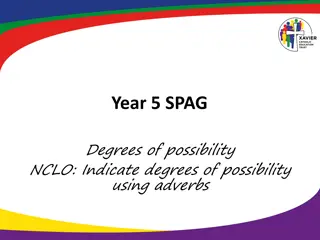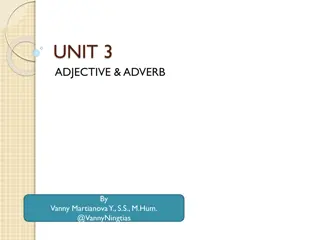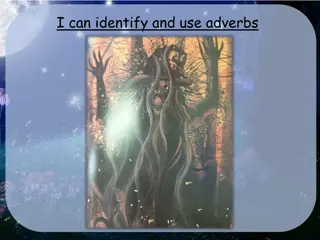Understanding Notional Parts of Speech: Adjectives and Adverbs
Exploring the notional parts of speech, this text delves into the properties and functions of adjectives and adverbs. Adjectives describe the qualities of substances, while adverbs characterize actions or qualities. Adjectives can be qualitative or relative, with degrees of comparison, while adverbs provide qualitative, quantitative, or circumstantial details. Understanding the suffix forms, derivations, and syntactic functions of adjectives and adverbs is essential for effective communication.
Download Presentation

Please find below an Image/Link to download the presentation.
The content on the website is provided AS IS for your information and personal use only. It may not be sold, licensed, or shared on other websites without obtaining consent from the author. Download presentation by click this link. If you encounter any issues during the download, it is possible that the publisher has removed the file from their server.
E N D
Presentation Transcript
Outline 1. The adjective 2. The adverb 3. The verb 4. The numeral 5. The pronoun
The adjective the lexico-grammatical meaning property of a substance - its material (woolen, wooden, silver), - its colour (white, red, brown), - dimensions (big, small, tiny, enormous), - position (inner, outer, upper), - state (calm, serene, upset), etc. Adjective forming suffixes V Adj -able, -ive, -ing, -ent, -ant, -ed, -ory. N Adj -y, -ful, -al, -less, -like, -ous, -ar, -ery, -en, -ed, -ish, -esque, -istic, -like, -ward, - wide.
The Adjective Qualitative denote properties of a substance directly (cold, beautiful), have the ability to make up degrees of comparison Relative express properties of a substance relating it to materials (wood wooden), to place (France French), to time (quarter quarterly) or to some action (to offend offensive, to oblige obligatory) The only grammatical category is the degrees of comparison positive (warm, nice, beautiful), comparative (warmer, nicer, more beautiful), superlative (warmest, nicest, the most beautiful). can be substantivized, i.e. converted into nouns: rich the rich, poor the poor characterized by a combinability with nouns, link-verbs, adverbs performs the syntactic functions of an attribute and a predicative
The Adjective possesses the following features: 1) the categorial meaning of property (qualitative or relative); 2) for qualitative adjectives the forms of the comparative and superlative degrees of comparison; 3) the specific suffixal forms of derivation; 4) adjectival functions in the sentence (attribute to a noun, adjectival predicative).
The Adverb the lexico-grammatical meaning - qualitative, quantitative or circumstantial characteristic of an action, a state or a quality lexico-grammatical subclasses: - qualitative adverbs (denote the quality of an action or a state (gladly, friendly) - quantitative adverbs (express the degree, measure, quantity of an action, a quality, a state (very, rather, quite) - circumstantial adverbs (indicate various circumstances attending an action (yesterday, tomorrow, before, often, never, once; downstairs, outside, beyond, westward). the suffix -ly is a typical marker of the adverb. However, many adverbs related to adjectives may not be necessarily used with the suffix -ly, e.g. fast, late, hard, high, clean, clear, close, loud, tight, firm, quick, right, sharp, slow, wide, etc.
The Adverb the grammatical category of degrees of comparison (adverbs of time, degree and manner) analytical, synthetical, suppletive combined with the words of different parts of speech: verbs, adjectives, adverbs, statives, nouns, e.g.: He drove quickly but carefully. Alex was sorry for his late arrival. He speaks French perfectly well. The child was fast asleep. The then policeman was interviewed. syntactical function of an adverbial modifier, attribute: -of manner, e.g. He reads English badly; the above classification, the then President.
The adverb possesses the following features: 1) the categorial meaning of the secondary property; 2) the specific suffixal forms of derivation; 3) the forms of the degrees of comparison for qualitative adverbs; 4) the syntactical functions of an adverbial modifier.
The Verb Semantic features: denotes a process developing in time, states, evaluation, forms of existence, etc. Morphological features: grammatical categories - person, number, tense, aspect, voice, mood, finitude and temporal correlation. The common categories for finite and non-finite forms are voice, aspect, finitude and temporal correlation. The grammatical categories - synthetical and analytical forms. Some categories (e.g. person, number) have synthetical forms only, others (e.g. voice) only analytical forms. Categories expressed by both synthetical and analytical forms are mood, tense and aspect. Function words, grammatical affixes and inner inflexions are the formative elements which express these categories.
The Verb Syntactic features: - modified by adverb - the function of the predicate - non-finite forms can be used in any function except the predicate - infinitive can be used in combination with a modal verb
Classifications of the English verbs morphological, lexical-morphological, functional and syntactical depending on different classification principles. 1. Morphological classification. - according to the stem-types: simple (to love), sound-replacive (food to feed), stress-replacive (present to present), expanded with the help of prefixes and suffixes (to undergo, to verify), composite (to babysit, to whitewash), phrasal (to take a bath, to give a nod). - according to the way of formation of the past tenses and Participle II: regular (to ask, to walk) and irregular (to sing, to write).
Classifications of the English verbs Lexical-morphological grammatical meanings of the verb. - according transitivity/intransitivity: transitive and intransitive - according to stativeness/non-stativeness: stative and dynamic - according to terminativeness/non-terminativeness: terminative and durative. This classification is closely connected with the categories of Aspect and Phase. classification is based on the implicit to the implicit grammatical meaning of the implicit grammatical meaning of the implicit grammatical meaning of
Classifications of the English verbs Syntactic classification - according to the nature of predication (primary and secondary) - finite and non-finite - according to syntagmatic properties (valency) the verbs of directed (to see, to take, etc.) and non-directed action (to arrive, to drizzle, etc.) Functional classification - according to the functional significance - notional (with the full lexical meaning), semi-notional (modal verbs, link-verbs), auxiliaries
The categories of person and number Do not convey any inherently verbal semantics, manifested in the verb from the grammatical featuring and interpretation of the subject. The expression of the category of person in the present tense is subdivided into: 1. The category of person neutralised with the modal verbs which have no personal inflexions (can, may, must, should, shall, will, need, ought, dare). 2. Suppletive personal forms of the verbal lexeme to be (am for the 1stperson Singular, is for the 3rdperson Singular). 3. The category of person is regular expression of with all the rest of the English verbs. The personal mark is expressed only in the 3rdperson Singular -(e)s [-z, -s, - iz], the 1stand the 2ndpersons remain unmarked (takes take, writes write, teaches teach). The category of person finds another mode of expression the future tense it marks not the 3rd, but the 1stperson (shall - will)
The category of tense The category of tense is a verbal category reflecting the objective category of time. Time is represented in language with the help of tense forms (takes, will take, has taken, took, has been taking, etc.), as well as with the help of various linguistic devices: 1) lexical: today, now, yesterday, tomorrow, etc. 2) lexico-morphological: post-graduate, pre-school, etc. 3) lexico-syntactical: next month, in a week, two years ago, etc. The essence of the category of tense is the relation of the time of the action or state expressed in the sentence to the time moment of the utterance. the basic tense distinction is traditionally presented as an opposition past :: present
The category of aspect a linguistic representation of the objective category of manner of action the opposition Continuous :: Non-Continuous, i.e. Progressive :: Non- Progressive. inseparable from the lexical meaning of verbs ( non-progressive verbs know, see, think, understand, taste, feel, love hate, etc. indicate a state of affairs rather than the action itself)
The Category of Voice Expresses the objective relation between the subject or object of the action and the action itself the opposition Active voice :: Passive voice. The implicit grammatical meaning of transitivity/intransitivity restricts the manifestation of this category to transitive verbs. Some grammarians recognize the existence of Middle, Reflexive and Reciprocal voices: The fish sells easily. He washed himself. They hugged each other. However, since these meanings find no morphological expression, it is not possible to speak of different voices.
The category of mood Mood expresses the relation of the action to reality, as stated by the speaker (acad. V. Vynohradov) 1. She walks quickly (the action is presented by the speaker as taking place in reality). 2. Walk quickly! (the listener is urged by the speaker to accomplish the action) 3. She would have walked quickly if she had been in a hurry. (the speaker perceives the action as imaginary) Different mood-forms of the verb walks, walk, would have walked convey different relations of the action to reality. There is no unanimous opinion among the grammarians to the category of mood in English: two the so-called direct moods (the Indicative Mood and the Imperative Mood) and four the so-called oblique (=indirect) moods:the Subjunctive I, the Subjunctive II, the Conditional Mood and the Suppositional Mood) (Prof. O. I. Smirnitsky) three moods the Indicative Mood, the Imperative Mood and the Subjunctive Mood (Prof. B. O. Ilyish, Prof. I. P. Ivanova)
The Verb The verb features: 1) the categorial meaning of process (finite and non-finite); 2) the verbal categories of person, number, tense, mood, voice, aspect; 3) the opposition of the finite and non-finite forms; 4) the syntactic function of the predicate for the finite verb.
The Numeral The lexico-grammatical meaning number The grammatical category of numerical qualification is represented by the opposition of two forms: cardinal numerals :: ordinal numerals. - cardinal numerals denote numerical quantity - ordinal numerals denote some numerical order. e.g.: nine ninth, five fifth, thirty thirtieth, sixty-two sixty-second, one hunred one hudredth. There are some further subdivisions of numerals - fractional numerals (whole, half, third, etc.) - collective numerals (pair, triad, dozen, twin, etc.) - multiplicative numerals (once, twice, thrice)
The Numeral Combinability with nouns and link-verbs: Twelve Monkeys; Ocean s Eleven; The Fifth Element; My son is fifteen; They were seven. Syntactic function of an attribute, subject. predicative: I have two books. Give me the second chance (attribute); Twelve is not divided by five (the subject); She is ten (the predicative). The features: 1) the categorial meaning of number (cardinal and ordinal); 2) specific composition forms for compound numerals; 3) the specific suffixal derivation forms for ordinal numerals; 4) the syntactic functions of a numerical attribute and a numerical substantive.
The Pronoun the main function deixis indirect nomination don t express new information have an extremely generalizing meaning, do not name any object or its quality, only point them out. some grammarians do not recognize the pronoun as an independent part of speech, because it has no specific syntactic functions or grammatical categories characteristic of pronouns alone
Semantic classification of pronouns Personal pronouns indicate all persons and things from the point of view of the speaker (I, you, he, she, me, her, him, we, us, etc) Possessive pronouns are expressed by the conjoint possessive pronouns (my, your, his, her, its, our), and the absolute possessive pronouns (mine, yours, his, hers, ours, theirs). Reflexive pronouns show that their first element indicated the person mentioned previously in the sentence (I myself, he himself, she herself, we ourselves, etc). Demonstrative pronouns show that the person or thing is near or far to the speaker in space or time (this, these; that, those, such, the same). Interrogative pronouns are used to form special questions (who, whom, what, which) Connective pronouns serve to connect clauses in complex sentences (who, what, which, whose, that). They are called relative pronouns if they introduce subordinate attributive clauses, and conjunctive pronouns if they introduce the other types of subordinate clauses. Reciprocal pronouns (each other, one another). Indefinite pronouns (some, any, something, anything, somebody, anybody, someone, anyone, one). Negative pronouns (no, none, nothing, nobody, no one, neither). Defining: generalizing pronouns (all, both, each, every, everything, everybody, everyone, either) and detaching pronouns pointing out one of the two (other, another, either).
The Pronoun the grammatical category of number : this these; that those (the demonstrative pronouns), other others (the detaching pronouns). the grammatical category of case (I me, he him, she her, we us, each other each other's, one another one another's; somebody somebody's; anyone anyone's; others others', etc). share the syntactic functions with the noun and the adjective: We live in Ukraine. Anyone can attend the lectures. (the subject); The professor asked him to leave. Who told you about it? (the object); These are my gloves. Tell us another story. (the attribute); It was not me. Those were us. (the predicative). the features: 1) the categorial meaning of indication (deixis); 2) the narrow set formal properties of categorial changeability; 3) the substantival and adjectival functions for different sets.
Reference literature 1. . . : . : , 2007. 328 . 2. . . Theoretical Grammar of English: Modern Approach. .: , 2009. 256 . 3. . . . : , 2009. 128 . 4. . ., . . . - . : , 2015. 200 . 5. Iriskulov A.T. Theoretical Grammar of English. Tashkent, 2006. 64 p. 6. Selivan L. Lexical Grammar. Cambridge Univ. Press, 2018. 244 p.



